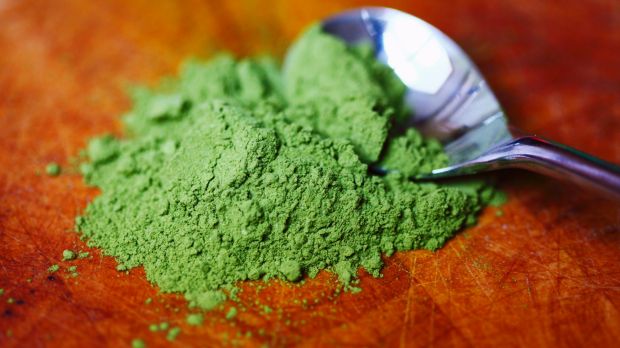
Food of 2015: Matcha green tea powder. Photo: Getty Images
Each and every year there are a couple of new foods that become part of our diet repertoire – a few years back it was chia, more recently kale and here a few that you may see a lot more of in 2015.
Kefir
A fermented drink made by mixing the kefir grain with milk which has been consumed for thousands of years known for its significant gastrointestinal benefits. To make kefir, milk (any milk) is combined with the kefir grain, which combines bacteria and yeast with casein protein, fat and lactose to produce a drink rich in microorganisms’ that have a powerful probiotic effect in the gut. Kefir can be consumed as a milk drink or as a yoghurt and can even be made at home combining a kefir-starting culture with milk. Nutritionally kefir is low in calories and is rich in vitamin B12, B1, and vitamin K and may be a great daily addition for anyone dealing with irritable bowel syndrome or other gut dysfunction.
Quark
A German dairy product with almost half the calories of Greek yoghurt and no added sugar, Quark has been used by dieters as a food that supports weight loss for some time. Quark is traditionally made without the use of rennet, and in production the curd is stirred to give a thick creamy texture similar to that of cottage cheese. Available in both full-fat and low-fat varieties, Quark has a mild tangy taste and can be used to cook in both sweet and savoury recipes and is a good source of protein and calcium.
Kalettes
Forget kale, now there is something even better – kalettes. The mix of kale and Brussel sprouts give you a new nutrient packed vegetable with a mild flavour and is much softer than a tough Brussel sprout. With a serve offering 30% of your daily vitamin C requirement and a massive dose of vitamin K, kalettes just became a whole lot more super than its parents. Cook in a little olive oil to maximise nutrient absorption.
Freekeh
Quinoa has had its day; freekeh is now where it is at. Freekeh is an ancient grain that originated from the Eastern Mediterranean. Freekeh is green wheat which is picked before maturity and then roasted and dried. Freekah can be considered a super grain with four times the fibre of rice and a good source of protein, iron, calcium and zinc and even though it is a relatively high-carb food with 26g total carbs per 45g serve, a significant amount of this carbohydrate is fibre. A great alternative to white rice or cous cous, if you are going to include grains in your diet, freekeh is one of the best varieties on offer.
Buckwheat
Visit any health food store or cafe and you will notice that buckwheat is being seen on menus more than ever before. Often thought of as a cereal grain, buckwheat is actually a fruit seed and makes a great substitute for grains for individuals who need to avoid gluten. The regular consumption of buckwheat is linked to both reductions in blood cholesterol and blood pressure, a benefit thought to come from the flavonoids or phytonutrients found in buckwheat. Also rich in magnesium and fibre, buckwheat flour can be used to make bread, pancakes and even pasta while the seed itself can be used as a base for salads.
Black rice
Originally it was white rice only, then we saw a brown rice as a common option and now it is not uncommon to see black rice sushi when you are buying your lunch. Rice that looks purpler in colour than it does black, especially when cooked, black rice can be found across a range of rice types and was traditionally considered a special type of rice based on the proposed health benefits it offered. Black rice contains a little more protein and fibre than brown rice as well as the powerful anthocyanin antioxidants linked to reductions in cancer risk. As is the case with all rice, black rich is still an energy dense food so needs to be consumed in controlled amounts, but a nutrient-rich one nevertheless.
Matcha
Forget white, green and even oolong, now the tea of the moment is matcha. Matcha is finely milled green tea powder and is thought to offer extra health benefits as you consume the entire tea leaf when you drink it, not just the water and as such are consuming significantly more antioxidants than you would usually get from a cup of tea. Matcha is also thought to have a stimulatory, and possibly fat-burning effect thanks to its relatively high caffeine content. So next time you are enjoying a cuppa at your local cafe, don’t be surprised if matcha is also on the menu.
